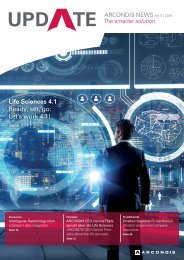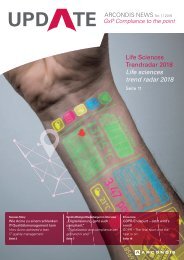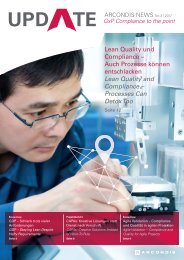ARCONDIS UPDATE No. 02|2018: The smarter solution
ARCONDIS Kundennewsletter für den Themenbereich Business Applications in Life Sciences Unternehmen
ARCONDIS Kundennewsletter für den Themenbereich Business Applications in Life Sciences Unternehmen
Sie wollen auch ein ePaper? Erhöhen Sie die Reichweite Ihrer Titel.
YUMPU macht aus Druck-PDFs automatisch weboptimierte ePaper, die Google liebt.
12_<strong>The</strong> <strong>smarter</strong> <strong>solution</strong> 13<br />
Persönlich versuche ich regelmässig vor Ort<br />
und damit für die Stakeholder zugänglich<br />
zu sein. Bei Ankündigungen bereite ich<br />
das lokale Management optimal auf diese<br />
Aufgabe vor, stehe selbst aber bewusst<br />
nicht im Vordergrund. Veränderungen werden<br />
besser angenommen, wenn sie nicht von<br />
aussen aufgedrängt, sondern vom lokalen<br />
Management getragen und kommuniziert<br />
werden – in der Sprache oder im Dialekt der<br />
betroffenen Personen. Simple Kniffe, aber<br />
mit enormer Wirkung. Denn wer sich ernst<br />
genommen und involviert fühlt, arbeitet<br />
motiviert mit, und das hilft dem Projekt.<br />
English<br />
E_New specialist knowledge in research,<br />
development and technology are the<br />
drivers for mergers, acquisitions and<br />
divestments in the life sciences industry.<br />
Many companies pursue a “Buy & Build”<br />
strategy – the acquisition of specific market<br />
segments to gain a leading market<br />
position. At the same time, they outsource<br />
production and packaging to focus<br />
on early, innovative phases of the product<br />
lifecycle. Mergers, acquisitions and<br />
divestments are therefore not only more<br />
frequent, but also becoming more agile.<br />
This April, Servier, the second largest<br />
pharmaceutical company in France, acquired<br />
the oncology division of Shire. In the same<br />
month, Shire itself accepted a billion dollar<br />
acquisition offer from Takeda. Johnson &<br />
Johnson, Roche, <strong>No</strong>vartis and other global<br />
players have also attracted attention by<br />
acquiring departments or even entire companies.<br />
<strong>ARCONDIS</strong> manager Dunja<br />
Hahn in an interview with<br />
<strong>UPDATE</strong><br />
Dunja Hahn is a manager in the Life Science<br />
Information Management department. With<br />
over a decade of consulting experience,<br />
she has profound multinational and crosshierarchy<br />
expertise in program and project<br />
management. Her focus is on organizational<br />
change and transformation management<br />
(OCM), including communication strategy<br />
and implementation. For the past three<br />
years, she has managed the divestments of<br />
several international production sites for a<br />
global pharmaceutical corporation.<br />
Ms. Hahn, you have accompanied several<br />
mergers, acquisitions and divestments in<br />
your role as a global IT project manager.<br />
What is unique about this type of project?<br />
I would summarize the challenges into three<br />
categories:<br />
First: Complexity.<br />
<strong>The</strong> high number of active stakeholders<br />
and functions in the form of local and<br />
global teams, potential buyers, vendors and<br />
external suppliers, as well as the linkages<br />
between business and IT, increase the complexity<br />
and can cause unclarity or stock-outs,<br />
or even disable business processes.<br />
Additionally, external factors such as inspections,<br />
ongoing projects such as system<br />
upgrades or country-specific regulatory<br />
requirements must be taken into consideration.<br />
Due to these internal and external factors<br />
and dependencies, project management<br />
and budget calculation are often difficult.<br />
<strong>The</strong>re is also the “human” factor: the mindset<br />
of affected persons can change drastically.<br />
Some employees are concerned about<br />
the future or, after years of loyal service, do<br />
not feel valued and may even feel disappointed<br />
– motivation dwindles and frustration<br />
grows. Cultural differences, both countryand<br />
company-specific, increase complexity<br />
and create barriers.<br />
Second: Agility.<br />
It is not only responsibilities, timelines or<br />
requirements that are constantly changing<br />
during a project, the scope can change suddenly<br />
and unexpectedly, as a result of the<br />
sale or closure of a location or department.<br />
Agile planning is crucial. Likewise, the team<br />
must be able to respond with flexibility to<br />
knowledge loss or experts due to terminations<br />
or restructuring measures.<br />
Third: Uncertainty.<br />
One of the greatest challenges of such a<br />
project is the uncertainty of what is planned.<br />
When it comes to divestments, the contractual<br />
partner normally is not known initially.<br />
As a result, the requirements of the buyer,<br />
as well as potential synergies with the new<br />
owner are often unclear at first, and only<br />
becoming more concrete during the later<br />
phases of the project, or even when the<br />
contract is signed.<br />
With M&A, there often is uncertainty about<br />
the extent of integration, including infrastructures,<br />
processes and applications of<br />
the two contractual partners. Anything is<br />
possible, from pure participation financing to<br />
a complete merger. This decision has a major<br />
impact on the subsequent harmonization<br />
process, addressed by the PMI (post-merger<br />
integration) activities.<br />
<strong>The</strong> uncertainty is tangible – will the new<br />
buyer show up tomorrow with entirely different<br />
requirements? Or will the project be<br />
stopped suddenly?<br />
<strong>The</strong> agreement can collapse just seconds<br />
before signing. All employees have to plan<br />
for this scenario, including a rollback, as<br />
well as be prepared for the “new owner’s”<br />
arrival, when it could happen that the previous<br />
managers and structures are still to be<br />
followed.<br />
Behind the scenes: What challenges<br />
specific to M&A and divestments did you<br />
face in your everyday project life?<br />
Personally, one obstacle is the initial small<br />
group of informed people able to discuss the<br />
details of the project. Negotiations are often<br />
kept under tight wraps until contract signing<br />
and official handover to the new owners.<br />
This presents both major and minor challenges<br />
on a daily basis. For instance, how<br />
do I obtain a complete application inventory<br />
to start the separation of the application<br />
landscape when the manager has not yet<br />
been informed about the imminent sale?<br />
<strong>The</strong>se types of situations require a certain<br />
personal flair, highlighting organizational<br />
change management as a key success factor<br />
in such a project.<br />
A divestment is always a unique situation.<br />
<strong>The</strong> affected local team members are rarely<br />
involved in projects of this type or dimension.<br />
<strong>No</strong>rmally, the new owner replaces<br />
previous management with its own staff,<br />
causing major uncertainty at both the functional<br />
and personal level.<br />
In my experience, even if these divestment<br />
projects are managed with a great degree<br />
of professionalism, it is essential to realize<br />
that emotions are involved and frustration is<br />
at a high level, especially for those affected<br />
by the change. <strong>The</strong>y fear for their jobs, are<br />
disappointed, and in some cases, they even<br />
feel cheated by the company they were<br />
loyal to for years. Unlike with M&A, not all<br />
contractual parties to a divestment have the<br />
same entitlements. This is why instinct and a<br />
sophisticated organizational change management<br />
system are crucial for the project to be<br />
a success.<br />
Additional to these human reactions, responsibilities<br />
and requirements change over the<br />
course of the project, or the company may<br />
lack experts, as management and specialists<br />
tend to be the first to “abandon ship.” This<br />
could result in unexpected situations that<br />
would normally be inconceivable in standard<br />
business practices. It is essential that even<br />
trivial activities and matters of course be<br />
addressed – for example a handover of all<br />
passwords for existing systems and applications<br />
to ensure their continued availability.<br />
How does one meet these challenges?<br />
My tip: “Think big. Start small.” <strong>ARCONDIS</strong><br />
has provided support for several M&A and<br />
divestments on both the business and IT<br />
sides. A good example is the migration of<br />
application landscapes following a company<br />
split (note from editor: covered in <strong>UPDATE</strong> 3<br />
| 2017).<br />
To respond to changing conditions with a<br />
certain level of flexibility, we recommend<br />
project management with shorter planning<br />
cycles. <strong>The</strong> extent of integration should be<br />
determined as early as possible, ideally<br />
during the acquisition process. Functions<br />
and roles should also be clearly defined and<br />
reevaluated over the course of the project.<br />
You named organizational change management<br />
as a critical success factor. What<br />
tips do you have as an OCM expert?<br />
When it comes to emotional topics like a<br />
change in ownership or even a shutdown,<br />
it is important that those affected by the<br />
change, feel that they are taken seriously.<br />
This is why OCM should not be something<br />
done “on the side” – but should instead be a<br />
defined step in the process.<br />
<strong>The</strong> goal is to break down both language and<br />
cultural barriers. It is nothing new when I<br />
say that training and regular status calls are<br />
necessary to prepare employees for new<br />
requirements and processes. It is important<br />
is to get feedback from those involved, and<br />
value their contributions. <strong>The</strong> best option is<br />
to take advantage of the existing meeting<br />
structure. As an example, a production site<br />
to be acquired by a CMO, held regular town<br />
hall meetings where we could give status<br />
updates during the project.<br />
Personally, I try to be on site regularly to be<br />
available to the stakeholders. When making<br />
announcements, I prepare local management<br />
teams for the tasks ahead, but do<br />
not take a leading role myself. Changes are<br />
better received when their origin is not from<br />
an outsider, but are instead addressed and<br />
communicated by the local management<br />
team in the language or dialect of the individuals<br />
affected. An unassuming approach<br />
with a major impact. After all, those who<br />
feel being taken seriously and involved in<br />
the process will cooperate, which in the end<br />
benefits the project.














